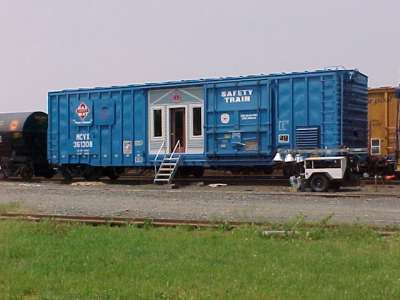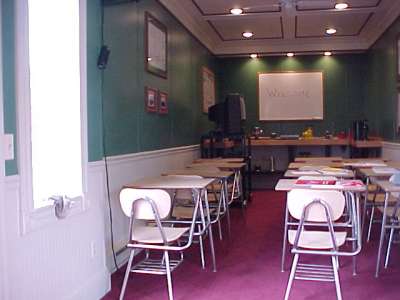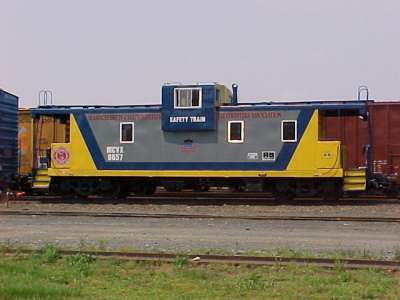

But thanks to him and the Safety Trains he created from scratch by coaxing the donation of a small fleet of rolling stock thousands of firefighters east of the Mississippi are better trained to respond to hazardous materials emergencies involving tank cars.
Five years ago, O'Neill recognized the need for firefighters to be trained on each of the three common types of tank cars used daily to haul propane, chemicals, and other hazardous materials. So O'Neill, then a lieutenant in the Sherborn, Mass., Fire Department, set out to gather tank cars and boxcars that could serve as rolling classrooms.
Everybody said, Yeah, sure, you'll get tank cars, O'Neill recalls skeptics saying. Initially, he was dismissed and only half-jokingly as a crackpot by railroad officials and tank car companies.
Today the Massachusetts Call/Volunteer Firefighters Association (MCVFA) has fielded two Safety Trains, and a third is being assembled. That the organization has even one running is as much a testament to the clear need for such a traveling classroom as it is to O'Neills drive to make it happen.
Real equipment used in simulated drills
For all their bravery, skill, and training to handle emergencies, most firefighters are ill-prepared for a hazmat derailment or incident involving tank cars. How much does the typical firefighter know about railroad equipment?
Not much at all, O'Neill says. And what they don't know could cost them their lives, or the lives of those they are trying to protect.
Part of the training problem, despite the existence of a handful of other company-run safety trains nationwide, is that it's hard to come by uncontaminated tank cars that could be used for training and drills.
In 1994, O'Neill helped organize a drill in Sherborn for 200 firefighters who responded to a simulated derailment involving tank cars.
But the only cars I could get were corn oil cars, not hazardous material cars, O'Neill says. They came complete with stencils of corn on the side of the cars.
What they didn't come with were the different types of valves found on pressure tank cars used to carry hazmat loads. Thus, the firefighters didn't learn to distinguish between a potentially dangerous car and a harmless one.
Shortly after the drill, the MCVFA obtained clean cars that were placed on a siding where firefighters could come to train.
I went panhandling for cars, quips O'Neill, who by day is a vice president at a Boston environmental firm.
It was a hard sell at first. I don't take no for an answer, O'Neill says. And you know I never run out of words.
That's for sure. Once he bends your ear, he won't let go. ACF donated the first car in 1996, and cars from GATX and Union Tank Car soon followed. The cars were near the end of their service lives, and the companies agreed to donate and paint them.
Later that year, Conrails Hazardous Materials Department encountered the same problem in obtaining clean chemical cars, so the railroad borrowed the MCVFA's cars and hauled them to its yard in West Springfield, Mass.
This set off a light bulb in O'Neill's head: Why not create a traveling safety train that could reach far more firefighters?
Building the Safety Trains
O'Neill persuaded then-Conrail CEO David LeVan to donate two boxcars for use as mobile classrooms. They were painted at the railroads Juniata Shops in Altoona, Pa. the only boxcars ever clad in Conrail blue and headed east to Massachusetts.
Working on weekends, O'Neill and a few volunteers then transformed the interior of one of the cars to resemble a Victorian-era train station, complete with white wainscoting and dark green walls. Theres seating for 25 people, a display of all the valves used on tank cars, and other visual aides.
The car is O'Neills pride and joy. To get the program off the ground and make an impression, O'Neill figured Safety Train I needed a first-class car that said this is a first-class program. It has been a hit.
Safety Train I consisting of the boxcar, the tank cars donated by ACF, Union Tank Car, and GATX, plus a caboose donated by CSX and painted in a locomotive-like scheme at its Huntington, W.Va., shops was dedicated in December 1999 at Washington Union Station. On hand for the occasion were members of Congress, the Federal Railroad Administration, and the Federal Emergency Management Agency, among others.
Safety Train II was completed last fall, and consists of a second classroom car, a DOT 111 tank car donated by GE Capital Railcar Services, a DOT 112 tank donated by Union Tank Car, a DOT 105 tank car donated by GATX, and a bay window caboose donated by Conrail and painted Pullman Green. Each piece of equipment carries MCVX reporting marks.
The trains have made more than 50 stops in 15 states from New England to the Midwest and Southeast, and trained more than 2,000 firefighters during sessions on CSX, Norfolk Southern, and numerous regionals and shortlines.
CSX hauls the trains for free, and provides a storage site for the equipment in its West Springfield yard. O'Neill and the MCVFA conducts training close to home, while CSX's hazmat department handles training on far-flung reaches of its system.
Basically, it's an awareness program for emergency responders, O'Neill explains. The training may involve three or four hours in the classroom car including basic railroad safety and then a couple of hours on the tank cars.
CSX spokesman Bob Sullivan says the railroad is glad to partner with the Massachusetts firefighters group. It's clearly valuable for us as a teaching tool, and it's something valuable for our hazmat people, Sullivan says. Having the tank cars in the train adds another dimension and realism to the training. “You can reach a lot more people, and it makes the training a little more memorable, Sullivan says.
Passenger train safety, too
O'Neill says that once the program got rolling, so did the support from the railroads and tank car companies. They're all great now, he says. Absolutely 100 percent, super cooperation. The support for something like this is just a phone call away.
The latest product of one of those phone calls is a former Chicago, Burlington & Quincy 10 & 6 sleeper, the Silver Isle, which Amtrak donated in September.
The car is added to Safety Train II when it heads for a training destination on a line that also has passenger service. The aim is to train firefighters in how to remove windows to evacuate passengers, instead of trying to break the glass.
Eventually, the MCVFA hopes a Safety Train III dedicated to emergencies involving passenger trains will include the Silver Isle, a coach, and a power car built in another former Conrail caboose.
For O'Neill, the title of Safety Train Manager doesn't come with a paycheck, but does include plenty of long hours spent waybilling cars and writing letters seeking financial or in-kind support for the train.
I took my two hobbies trains, and being a volunteer firefighter and turned it into the Safety Train, O'Neill says.
Just doing this as a labor of love is enough for ONeill. Firefighters, railroads, and the public are all safer for it.
(For more information on the Massachusetts Call/Volunteer Firefighters Association Safety Train, contact John O'Neill at 508-647-6915, or e-mail him at sfytrain@tiac.net. The associations Web site is at www.mcvfa.org)


